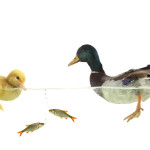Being a CEO is a position I thrive in. As a child, I did not know that this was what I one day would become. In my youth I had moments when I wanted to be a lawyer and a litigator. But most of the time, I simply didn’t think or care about my future.
People often grow up not thinking of a leadership role for themselves, yet many have the aptitude and will make great CEOs one day. I hope my story will inspire those people. The CEO role is not as unreachable as it seems. Great CEOs are not born; they are made – by themselves and by people around them who support them.
Mind of a misfit
Perhaps you need to be something of a misfit to become an entrepreneur or CEO. The awkward feeling of a child of not fully fitting into the given collective can be a powerful driver of independent thinking, confidence and courage.
In too much of abundance, nonconformance will become a hindrance of those positive developments, and a leadership role may not be achievable. But if you are not a misfit at all, the leadership role also isn’t achievable, because you have not been confronted with the useful character-building challenges.
You may also feel like a misfit without actually being one. Adults can be surprisingly simple-minded and judgmental. They may declare as weakness a characteristic that in reality is a strength. Whether the sense of not fitting in has internal or external causes, in moderate proportions it is a useful feeling. Perhaps every single child is and needs to be a misfit.
As a child I felt I had a capable brain and strong willpower, but I didn’t learn to fully fit into to my social environment until in my late teens. Perhaps I still don’t always fit in.
This is a key dimension of entrepreneurial CEOs and founders. They don’t fully fit in, and they are fine with it. They turn being different into a strength. Like the children in Astrid Lindgren’s wonderful books.
Weaknesses became strengths
As you grow into leadership roles, you may note that what in your early years were your weaknesses may over time manifest themselves as strengths.
Several of my later strengths started out as weaknesses:
- I was stubborn. Now I am persistent.
- I was self-centric and self-serving. Now I value equality and mutual respect.
- I was a day dreamer. Now I can envision things and think creatively about strategy.
- I was reserved and socially aloof. Now I am a good listener and observer.
- I resisted my father’s authority. Now I am unafraid of expressing my true opinion.
- I took orders from my older brother and gave orders to my younger brother. Perhaps this taught me the importance of the chain of command.
Naturally the above is a simplification. Some of my weaknesses are still there, and some new ones have emerged! My point is that every cloud has a silver lining. If we believe in ourselves and if we are determined to head in some direction, we can do so.
First leadership experiences
My first experience of leadership was in the boy scouts, where I was put in charge of a small troop. More practice followed during my military service in the Finnish Navy. After that I held leadership roles among students at the university. From there I jumped into entrepreneurship and ultimately into the CEO role around the age of 35.
The scouts and the navy were valuable leadership experiences. There I learned to lead whoever joined. In the scouts you can’t deny anyone access, which means that no one can be fired. Also in the military service, you can’t really fire anyone, but neither can they resign. They are bound (in Finland where I grew up) by compulsory conscription.
The university clubs and associations gave a new leadership experience. I learned to lead those who are there on a voluntary basis. In a startup you can also pick your team, and as a team member you can pick your leader. I have learned that this degree of mutual voluntarity produces the best environment for leadership.
The basic principles of my leadership style were set during the formative years of my leadership development:
- Assume the best of people and don’t punish them for honest mistakes
- Work *with* those you lead, not above them
- Share information openly; don’t base your leadership on secrets
- Stop to reflect over the input your team provides you; it may be the best advice you ever get
- Set goals and celebrate every step towards the goal
- Although you work *with* the team, as a leader always take a moment to think for yourself beyond the current moment and about the longer-term implications and the longer-term goals.
Becoming and being a leader
You may not sense it when it happens, but becoming a leader is a simple act. It happens the moment you take just a little bit more responsibility than you were supposed or expected to. You are as big a leader as the responsibility you shoulder.
When your scope of responsibility grows, it will soon encompass other people. To deliver on that responsibility, you must focus on making *someone else* successful in their job. That’s leadership of people. When you get there, you will stop expressing dissatisfaction. Complaining is for those who have no influence or control. As a leader, you always have influence and control. Hence you will take action and not display dissatisfaction.
On a still higher level of leadership, you not only enable your team to be successful; you help generate more leadership. You spend your energy identifying and enhancing the strengths of those who report to you, while helping them deal with their weaknesses. As a result, you create more leaders.
The ultimate test of leadership is when you leave the organization. If you fulfilled your leadership mandate, you will leave subordinates behind you who are ready and capable to step up and fill your role. Many times they will do a better job than you did. That, too, counts as *your* success.
This has been my path. It is equally likely or unlikely as anyone else’s. Being open to experiences, acting in a constructive way and taking responsibility are the keys to developing leadership skills. We can start early or start late. It helps if someone believes in you even more than you yourself can believe in you. But it is ultimately your decision – your first step to take and you do it with others, not alone.
Mårten Mickos
















LOVE this. Thank you Marten 🙂
Spot on, this is exactly on the lines I’ve recently thought about since I’ve really worked hard to get through my “insecurities” and turned them into my strengths and building my character. Nothing teaches you about life and some great skills like a hard wall of rejection and not fitting in.
Also about not fitting in:: the blessing in disguise here is the fact that since it doesn’t matter where you go, you will be that misfit, it means really that you can go *any where* you want to as long as you are in terms with it yourself. You can welcome yourself to any party and company without needing to fit in. That is a powerful asset to carry. And if you got something to share and say, people might start to listen to you. What a delicious position to be.
And I fully agree with the fact that you should treat other one around you as your peers rather than someone below you. I have zero problem in empowering people around me because I see the possibilities in them that they perhaps aren’t aware of, or guide them to directions they should be going. They are as much as leaders as I am. They just might need that someone to show them that and if I can help them, awesome. They can later repay it by doing it to someone else. That’s the true capital there is.
Thanks for this confirming writing! Great way to start this week 🙂 Have a good one!